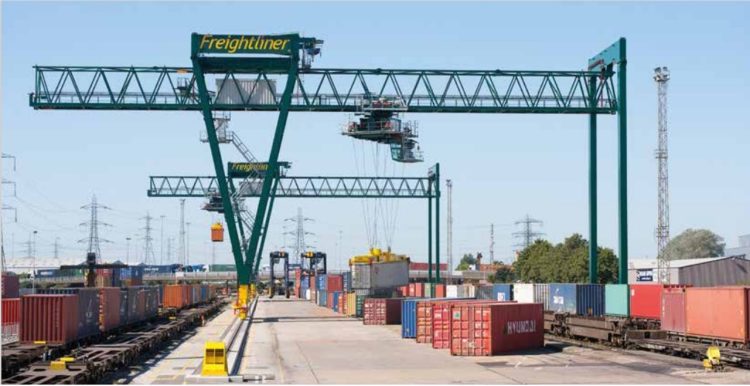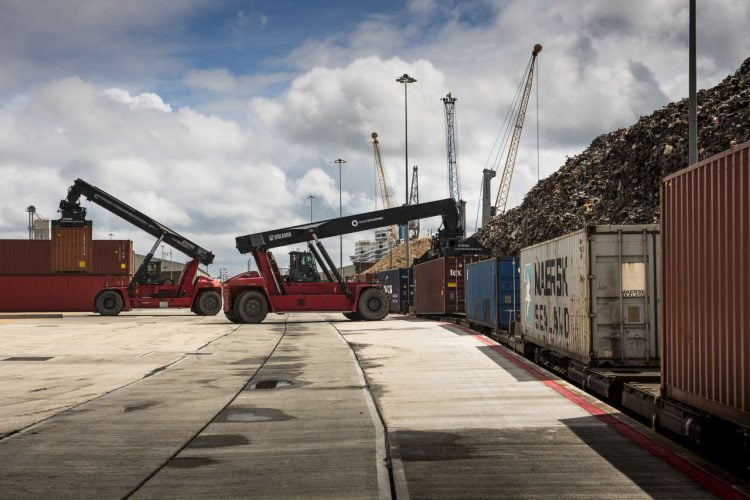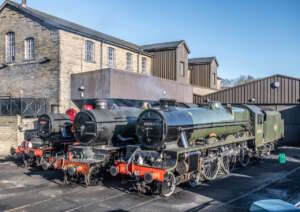Transport Secretary, Mark Harper has announced an ambitious target to increase the amount freight transported by rail across the UK by rail by at least 75%.
The announcement made today, Thursday,, 20 December, is in line with the Government’s drive to grow the rail freight industry, and boost the economic growth it brings with it by supporting supply chains and thousands of highly skilled jobs.

The target provides the sector with certainty as it not only sets a clear pace for growth by 2050, but by taking lorries off the roads it will also lead to significant environmental benefits through slashing emissions and congestion. As an example, a single train can replace up to 129 HGVs, whilst a tonne of freight moved by train produces about 75% less carbon emissions than by road.
This announcement fulfils commitments made earlier this year by the Transport Secretary made a in his George Bradshaw address and the Department for Transport’s Plan for Rail and Transport Decarbonisation.

Following a detailed consultation with industry leaders, customers, and other stakeholders by the Great British Railways‘ Transition Team (GBRTT), the transformative Ely Area Capacity Enhancement scheme that was recently announced through the Network North plan will be supported by around £550 million of Government funding. Six extra freight trains per day to and from the Port of Felixstowe will remove the equivalent of 98,000 lorry journeys off the road each year.

Transport Secretary Mark Harper said: “Rail freight helps keeps this country moving, ensuring our supermarket shelves are stocked and materials are supplied to our construction workers.
“Not only is it the most efficient and environmentally friendly way of transporting many goods, but it helps grow the economy across the country.
“This ambitious plan demonstrates this Government’s confidence in the rail freight sector, and I hope it encourages businesses to capitalise on the extra opportunities, so the industry continues to thrive and deliver for our country.”
GBRTT’s Lead Director (interim) Rufus Boyd said: “The Government’s announcement today, for a rail freight growth target of at least 75% growth by 2050, supports what our customers and stakeholders told us in the national Call for Evidence. That setting a clear ambition for rail freight growth will help bring the sector together, focus minds, break down silos, and be a catalyst for private investment.
“Rail freight is already a big success story. Moving goods by rail is a greener option and helps cut road congestion, and what we have here is an opportunity to grow rail freight’s modal share. I am convinced that through collaborative working the industry can rise to this challenge.”
Director General of the Rail Freight Group Maggie Simpson said: “We are delighted that Government has recognised the economic and environmental benefits of growing rail freight. This target sends a strong message about the benefits and potential of rail freight which will encourage investment by industry and private businesses and attract more customers to move their goods by rail.”
Network Rail freight director Henry Bates said: “Rail freight has a key role to play in Britain’s economic and environmental wellbeing, keeping supermarkets stocked, builders building and medicine moving. We want to see more freight on rail and having a Government supported, long-term target will support the sector’s ambition to grow and attract investment.”
Commenting on the announcement of a rail freight growth target of 75% by 2050, Rail Partners chief executive, Andy Bagnall said: ‘Today’s announcement of a growth target for rail freight is a major step forward – the target will focus minds on the need to move goods in a more environmentally friendly way and give the sector more clarity to encourage investment.
‘While the 75% level of the growth target is a good start, we will need to go further to really shift the dial of moving freight from road to rail – if rail freight simply maintained its market share, that would mean 60% growth by 2050. So, the sector will now continue to work with government to put in place the policies needed to achieve, and exceed, the target – essential if the UK is to decarbonise logistics supply chains and meet its net zero goals.’






Responses
Given the lack of capscity caused by the cancellation of HS2, this statemrnt, promising 75% in 30 years time, is frankly yet another campaigning statement from a government trying to deflect attention. Without HS2 in any form,the capacity just isn’t going to be there..
The sums of money apparently ” saved” by not proceeding with HS2 are going to be frittered away on a few minor projects. A few hundred million spent here and there might impress the poorly informed,,but will be a massive cut in investment. The much smaller total amounts of investment will be spent on piecemeal projects, which will have nothing like the benefit of a more ambitious whole route programme of doubling and
electrification on the route from Felixstowe to the Midlands
Dr Beeching took freight off the railways and put it on the roads. Going back to rail freight shows what people have been saying for decades. He was clueless.
I don’t understand how a doctor of tropical medicine could be responsible for “sorting out” the railways.
Would you let a train driver, with respect, treat you for malaria?
Not only should we move more freight by rail, we should use more electric traction ,but currently this is more expensive.
It’s not a “false” economy”, as someone has suggested! If you can change a shipment from 300 miles of road to 20 miles of road and 280 miles of rail, the energy saved and the GHG emissions reduced will be enormous. That’s why more and more freight yards are being extended to offer multi modal facilities and more and more multi modal yards are being built.
For the last 5 years I’ve been part of a team that has designed and built a ‘Google Maps for rail freight and one of the modules within it takes the train’s consist, driver behaviours, track gradients, wind resistance within tunnels, weight of the train and calculates the best routes in terms if energy consumed and emissions outputted. Even the government don’t record data with this level of detail and accuracy.
Express parcels and mail used to travel on passenger trains. Couldn’t we devise an inventive way of making that possible again ? Maybe a separate module that could detach from the passenger train ?
I think moving more freight by rail is a good thing, but like some other people have said, the freight still needs to be taken by road for the final leg of it’s journey from the Depot, so it’s a false economy, because you don’t actually end up reducing the amount of lorries on the road.
Maybe some of these companies could have their own rail line built, so the trains could get directly to them, a bit like Tesco has.
I guess it’s time to reopen a lot of lines that we lost before my time, at the end of the Steam age, to boost capacity for both freight and passengers, and to allow the large increase in rail freight.
Bit difficult when DB Cargo UK are selling off many of their locomotives!!
HS2 has sucked up all the money which could have gone towards restoring capacity for freight across the whole country, instead of just the WCML axis. It was over-specified and then over-spent. These governmental ambitions are all very well but where are the actual plans to achieve them?
As Steve rightly points out you still need the lorries to move the goods / containers to and from the local rail terminal. Having worked at DIRFT for several years I’ve seen it first hand. Lorries bring containers up from London to DIRFT to then be tailed into Scotland. Why not just rail them from London and introduce stopping trains that load / unload along the way. Tesco run a DIRT to Goole train then then for example has a lorry run goods back to Lincoln and beyond which is hard to fathom out the cost savings. As for HS2 being built… In reality would it make a blind bit of difference as all the existing stations will still need to be serviced by the same amount of passenger trains, potentially even more if passenger numbers increase further. As for freight running via HS2 lines that wouldn’t work as all the terminals such as DIRFT, East Miss, Northampton would need connecting too! Remember HS2 even if built as originally planned has so few stations most commuters wouldn’t use it, wouldn’t be prepared to pay the no doubt over inflated prices anyway.
HS2 would not benefit rail freight. Then there is the cost of rail freight too. The big players on the domestic container services could be more efficient for starters!
By removing high speed trains from the West Coast, Midland and East Coast Main Lines, HS2 – built in full – would give a massive increase in capacity on all three lines both for freight and local passenger services.
If HS2 had gone ahead as originally planned then passenger traffic would have been transfered to HS2 freeing up more capacity for rail freight removing thousands of containers off the roads and onto rail.
Its about time that more freight was moved by Rail.
The current network is at saturation point already hence the need for hs2 and restoration of lines lost going back to the breeching cuts.
Perhaps the dft should allow train companies longer trains and less of them then you might have some more room for freight
As a lorry driver, putting freight on trains is all great and everything. But each train needs 129 lorries to take the goods from the rail depot to the customer. So it doesnt take lorries off the road. It puts more on the road!. Do they think the goods magically get from rail terminal to customer? And more often than not it still has to go 70 to 80 miles by road!
They might need to build HS2 first
We don’t have to go back to the pre-Beeching pick-up goods days which were inefficient in terms of distribution. Trains can travel between ports and distribution centres so carrying goods over long distances in bulk. Lorries and vans would then be used for relatively short journeys to shops or direct to people’s homes. Reducing lorry miles is not only good for the environment but addresses the chronic shortage of lorry drivers.